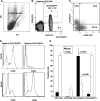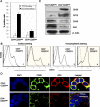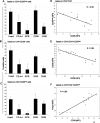Generation and accumulation of immunosuppressive adenosine by human CD4+CD25highFOXP3+ regulatory T cells
- PMID: 19858205
- PMCID: PMC2844167
- DOI: 10.1074/jbc.M109.047423
Generation and accumulation of immunosuppressive adenosine by human CD4+CD25highFOXP3+ regulatory T cells
Abstract
Naturally occurring regulatory T cells (nTreg) are crucial for maintaining tolerance to self and thus preventing autoimmune diseases and allograft rejections. In cancer, Treg down-regulate antitumor responses by several distinct mechanisms. This study analyzes the role the adenosinergic pathway plays in suppressive activities of human nTreg. Human CD4(+)CD25(high)FOXP3(+) Treg overexpress CD39 and CD73, ectonucleotidases sequentially converting ATP into AMP and adenosine, which then binds to A(2a) receptors on effector T cells, suppressing their functions. CD4(+)CD39(+) and CD4(+)CD25(high) T cells express low levels of adenosine deaminase (ADA), the enzyme responsible for adenosine breakdown, and of CD26, a surface-bound glycoprotein associated with ADA. In contrast, T effector cells are enriched in CD26/ADA but express low levels of CD39 and CD73. Inhibitors of ectonucleotidase activity (e.g. ARL67156) and antagonists of the A(2a) receptor (e.g. ZM241385) blocked Treg-mediated immunosuppression. The inhibition of ADA activity on effector T cells enhanced Treg-mediated immunosuppression. Thus, human nTreg characterized by the presence of CD39 and the low expression of CD26/ADA are responsible for the generation of adenosine, which plays a major role in Treg-mediated immunosuppression. The data suggest that the adenosinergic pathway represents a potential therapeutic target for regulation of immunosuppression in a broad variety of human diseases.
Figures






Similar articles
-
Alterations in the adenosine metabolism and CD39/CD73 adenosinergic machinery cause loss of Treg cell function and autoimmunity in ADA-deficient SCID.Blood. 2012 Feb 9;119(6):1428-39. doi: 10.1182/blood-2011-07-366781. Epub 2011 Dec 19. Blood. 2012. PMID: 22184407 Free PMC article. Clinical Trial.
-
CD39+Foxp3+ regulatory T Cells suppress pathogenic Th17 cells and are impaired in multiple sclerosis.J Immunol. 2009 Dec 1;183(11):7602-10. doi: 10.4049/jimmunol.0901881. Epub 2009 Nov 16. J Immunol. 2009. PMID: 19917691
-
CD4(+)CD25 (+)CD127 (low/-) T cells: a more specific Treg population in human peripheral blood.Inflammation. 2012 Dec;35(6):1773-80. doi: 10.1007/s10753-012-9496-8. Inflammation. 2012. PMID: 22752562
-
Targeting adenosine and regulatory T cells in cancer immunotherapy.Hum Immunol. 2021 Apr;82(4):270-278. doi: 10.1016/j.humimm.2020.12.005. Epub 2021 Feb 18. Hum Immunol. 2021. PMID: 33610376 Review.
-
Regulatory role of CD39 and CD73 in tumor immunity.Future Oncol. 2024;20(19):1367-1380. doi: 10.2217/fon-2023-0871. Epub 2024 Apr 23. Future Oncol. 2024. PMID: 38652041 Free PMC article. Review.
Cited by
-
Influencing factors and solution strategies of chimeric antigen receptor T-cell therapy (CAR-T) cell immunotherapy.Oncol Res. 2024 Aug 23;32(9):1479-1516. doi: 10.32604/or.2024.048564. eCollection 2024. Oncol Res. 2024. PMID: 39220130 Free PMC article. Review.
-
Tregs in transplantation tolerance: role and therapeutic potential.Front Transplant. 2023 Aug 30;2:1217065. doi: 10.3389/frtra.2023.1217065. eCollection 2023. Front Transplant. 2023. PMID: 38993904 Free PMC article. Review.
-
Enhanced immunosuppressive capability of mesenchymal stem cell-derived small extracellular vesicles with high expression of CD73 in experimental autoimmune uveitis.Stem Cell Res Ther. 2024 May 23;15(1):149. doi: 10.1186/s13287-024-03764-7. Stem Cell Res Ther. 2024. PMID: 38783393 Free PMC article.
-
Therapeutic and immunomodulatory potentials of mesenchymal stromal/stem cells and immune checkpoints related molecules.Biomark Res. 2024 Mar 21;12(1):35. doi: 10.1186/s40364-024-00580-2. Biomark Res. 2024. PMID: 38515166 Free PMC article. Review.
-
Platelets induce CD39 expression in tumor cells to facilitate tumor metastasis.Br J Cancer. 2024 May;130(9):1542-1551. doi: 10.1038/s41416-024-02640-8. Epub 2024 Mar 9. Br J Cancer. 2024. PMID: 38461171
References
Publication types
MeSH terms
Substances
Grants and funding
LinkOut - more resources
Full Text Sources
Other Literature Sources
Research Materials
Miscellaneous

